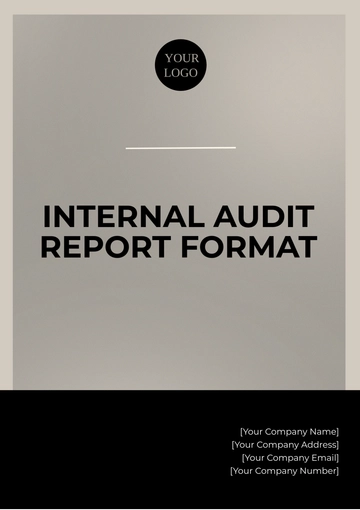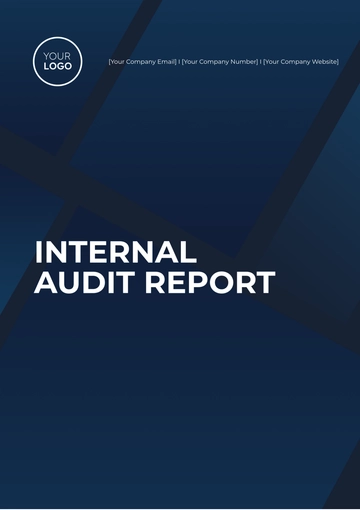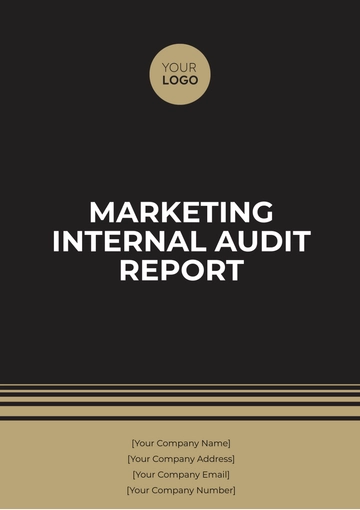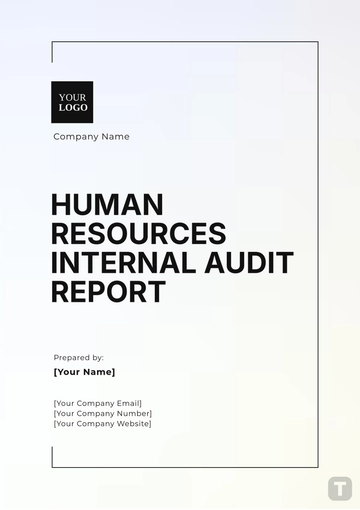Financial Internal Audit Report
Executive Summary
This internal audit was conducted to comprehensively assess the financial operations, controls, and reporting mechanisms of [Your Company Name]. The primary objective was to evaluate the effectiveness of internal financial controls, the efficiency of operational processes, and compliance with relevant accounting standards and legal regulations. Additionally, the audit aimed to ensure the accuracy, integrity, and transparency of the financial reporting framework, focusing on mitigating risks and enhancing governance.
Scope and Objectives
The audit examined the financial transactions, systems, and controls for the period from July to August, focusing on key financial areas. The main objectives of this audit were:
Evaluating internal controls over financial reporting, including processes for authorization, verification, and reconciliation of transactions.
Ensuring compliance with applicable laws, industry regulations, and financial reporting standards (such as GAAP or IFRS).
Assessing the accuracy and completeness of the financial records, ensuring all transactions are properly documented and reflected in financial statements.
Identifying gaps or inefficiencies in current processes and proposing improvement solutions.
Providing strategic recommendations to enhance internal controls and operational efficiency while mitigating financial risks.
Methodology
The audit was conducted using a combination of in-depth document reviews, procedural walkthroughs, data analytics, and interviews with key finance and accounting personnel. The following steps were undertaken:
Review of financial policies and procedures: Analysis of the organization’s financial policies, including budgeting, expenditure approval, and cash flow management.
Examination of financial statements: Detailed scrutiny of the balance sheet, income statement, cash flow statement, and supporting documentation.
Testing of internal controls: Spot checks and sampling to evaluate the effectiveness of controls in areas such as payment approvals, payroll processing, expense reporting, and ledger reconciliations.
Interviews with key personnel: Discussions with the finance team, accounting staff, and department heads to gain insights into procedural adherence, financial system performance, and any operational challenges faced during the reporting period.
Findings and Observations
The audit identified several areas where internal financial controls and processes could be optimized. The key findings are as follows:
Observation 1: Weaknesses were found in the expense approval process, with some transactions lacking the necessary supporting documentation, leading to a potential risk of unauthorized expenditures.
Observation 2: The reconciliation process for bank statements was found to be inconsistent, resulting in delays and discrepancies in monthly closing. This poses a risk to the accuracy of cash flow reporting.
Observation 3: While the organization has a comprehensive financial policy, there is limited training provided to staff, leading to varying degrees of policy compliance across departments.
Data Analysis
The audit also included a thorough analysis of the financial data to identify trends, anomalies, and areas requiring improvement.
Revenue Analysis
Month | Revenue | Variance (%) |
|---|
January | $100,000 | - |
February | $120,000 | +20% |
March | $110,000 | -8.33% |
The audit found that revenue fluctuated over the three months due to seasonal demand variations. However, no significant anomalies or inconsistencies were noted.
Expense Analysis
Expense Category | Amount | Percentage of Total |
|---|
Salaries | $50,000 | 40% |
Rent | $10,000 | 8% |
Utilities | $5,000 | 4% |
Expenses remained consistent with historical patterns, but a notable observation was that salary costs accounted for a high percentage of total expenses, indicating potential opportunities for cost control and workforce optimization.
Recommendations
Based on the findings, the following strategic recommendations are proposed to improve the organization’s financial operations and strengthen internal controls:
Recommendation 1: Implement stricter expense authorization protocols to ensure all transactions are properly documented and authorized by the appropriate personnel, addressing the gaps identified in the expense approval process.
Recommendation 2: Automate the reconciliation process for bank statements to reduce delays, improve accuracy, and streamline the monthly closing process, thereby enhancing the reliability of financial reports.
Recommendation 3: Develop a comprehensive financial training program for all finance and accounting staff to ensure uniform understanding and adherence to the organization's financial policies, minimizing discrepancies across departments.
Conclusion
In conclusion, the financial internal audit of [Your Company Name] identified strengths and areas requiring improvement. The audit highlighted the organization's robust revenue generation but also underscored the need for enhancements in expense management, reconciliation processes, and staff training. Implementing the recommendations outlined in this report will lead to greater operational efficiency, stronger internal controls, and improved compliance with regulations and financial reporting standards.
This report was prepared by [Your Name]
Report Templates @ Template.net






























